Updated: 13-Feb-2020
The Corvair name belongs to the Chevrolet car model between 1960 and 1969.
-It has features that make it especially adaptable to an aero engine with its six horizontally-opposed, air-cooled cylinders.
-It is a conversion to be used mainly in homebuilts. Outstanding are FlyCorvair, Ultravair, Redrives, etc.
-There is a two-cylinder engine, "cut" from the Corvair six-cylinder engine we dealt with. It is made by UV, Ultra-Vair (see).
-They could have direct transmission to the propeller or use a PSRU (Propeller Speed Reduction Unit).
-The standard car engine was rated at about 65 hp. The FlyCorvair modifies it, and power is increased to 100 hp.

"FlyCorvair" (PiP)
-We see the a FlyCorvair installation in a cell, accessible and clear.
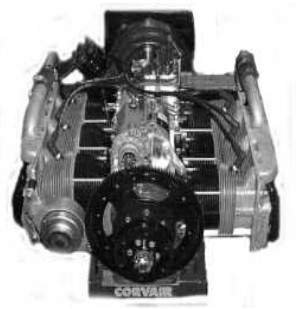
"Corvair 100"
-The displacement is 3,100 cc. In the picture above you can see a crown wheel and the electric-starter drive pinion.
-This device does not appear in the version made by CorvAircraft that is showed below. It has no starter crown wheel, and it has a three-blade propeller, and in this photo the rocker covers were not in place.

“CorvAircraft.” (PiP)
-As a curiosity, the work done by Ultra-Vair is similar to that, done by those who shortened VW engines.
-In this case the cut engine is the Corvair 6-cylinder that remained with only two cylinders.
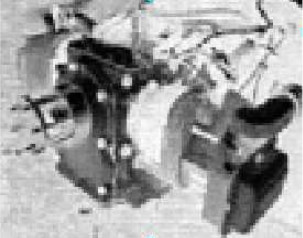
“Corvair 2-cylinder version” (PiP)
-This two-cylinder version gives 35 hp at 3,500 rpm., and weighs 80 lbs.
From Appendixes 6 and 7: It is common to find more conversions of this interesting car engine (Chevrolet-Corvair) applied in American homebuilts, as is the case in the following illustrations.

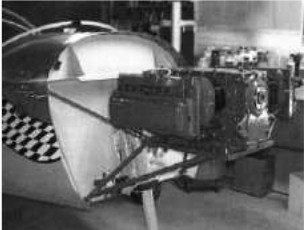
“Two installed Corvair engines” (PiP)
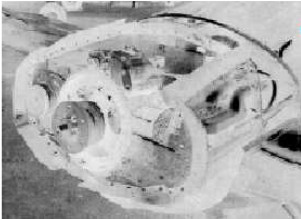
“And a third Corvair conversion” (PiP)
-In the Corvair engine chapter that actually is a Chevrolet, we show the conversions for aviation.
-Now we have a cutaway drawing with the fan and its deflector plates as well as the air filter with the ducts to the carburetors, just as in a car installation.
-Once these devices are removed, there is a truly aeronautical-looking, 6-cylinder engine.
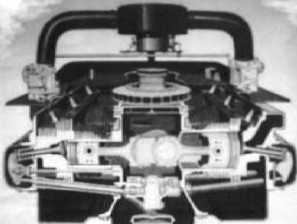
"Chevrolet Corvair engine"
From Appendix 10: Engine adapted from a Chevrolet Corvair automobile to be used aeronautically.
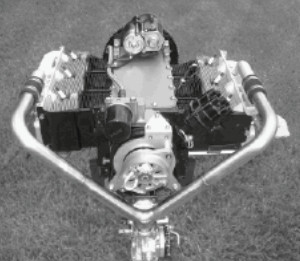
"Corvair 6-cylinder boxer"
-Outstanding are the long mixture intake ducts, from the very low positioned carburetor to the cylinders, in a large "V".
-It seems to the author that due to the mixture speed inside, water condensation on the outside of the collectors must be recurrent. Unless you have some heating system.
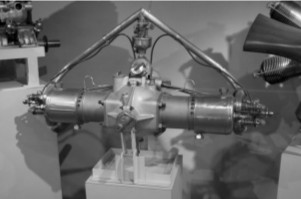
"Darracq engine witn long collectors too"
-Seeing the Corvair engine made me think of the example of another aviation engine, the Darracq, with an extremely long intake manifold duct too. And surely with the same problem of external condensation. Moreover, the Darracq has an upstream carburetor to return downward, not precisely in a "sweet" way. The reason for this design is not known.
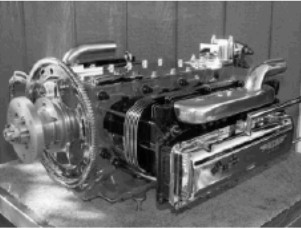
"Exquisite Corvair preparation"
Engines of CORVAIR
Model: FlyCorvair
Arquitecture: 6-cylinder Horizontally opposed
Cooling: Air
Total Displacement: 3100 cc
Bore / Stroke:
Power: 100 HP @ rpm
Weight:
Converted Chevrolet Corvair engine.

"FlyCorvair 100 hp"
Model: Ultra-Vair 2-cyl.
Arquitecture: 2-cylinder Horizontally opposed
Cooling: Air
Total Displacement:
Bore / Stroke:
Power: 35 HP @ 3500 rpm
Weight:
Two-cylinder engine, "cut" from the Corvair six-cylinder engine. It is made by UV, Ultra-Vair. They could have direct transmission to the propeller or use a PSRU (Propeller Speed Reduction Unit).


